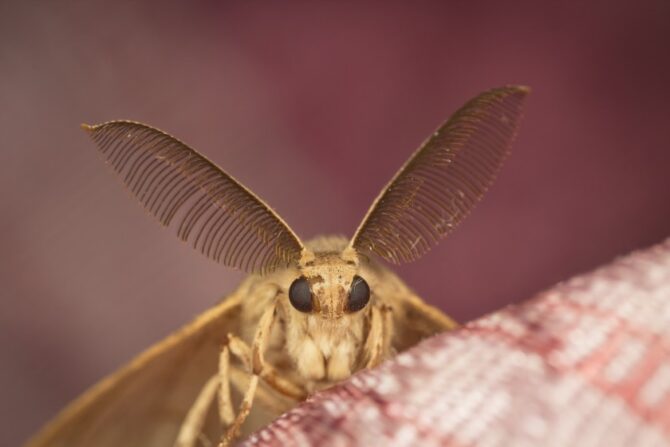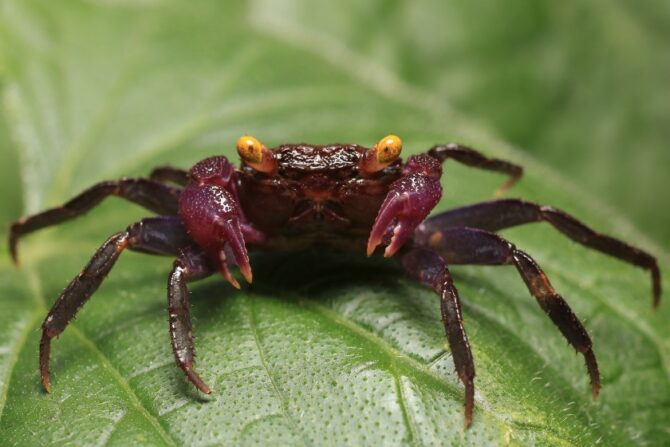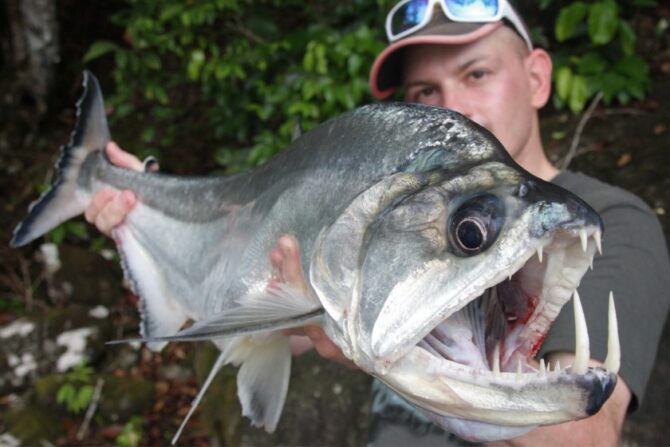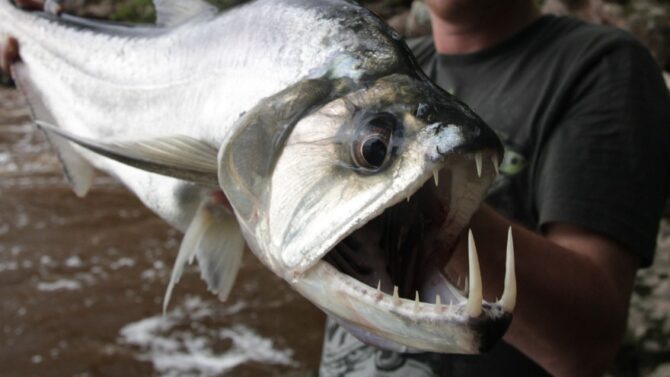Vampires are mythical creatures that are known for their predatory natures and their ability to survive on a predominantly blood diet.
In as much as we all know that they do not exist, some animals that portray vampire features were named after them.
Some animals that look like vampires include the vampire squirrel, Dracula ant, vampire flying frog, vampire moth, etc.
This article will feature ten animals that have been associated with these mythical creatures either because of their hunting and feeding habits, their coloring, or their dental structure.
Top 10 Animals Named After Vampires
1. Vampire Moths

It is believed by most that mosquitoes are the only blood-sucking insects that exist.
This assumption has been disproved. There are bloodsuckers in existence that we have no idea about.
The vampire moth happens to be one of them. Scientifically known as Calyptra thalycitri, the vampire moth is commonly seen in central and southern Europe. Its diet is comprised of fruit.
This said researchers discovered a Russian populace of vampire moths that use their proboscis to drill through the hides of elephants, buffaloes, and even human skin.
The proboscis is coiled and straw-like; these animals insert this appendage of theirs after they select a favorable spot on their victim. Once the blood wells up, they feast on it.
Interestingly, only the male vampire moths consume blood. The common hypothesis is that they do this to supply their females with enough salt during mating, thus leading to very healthy larvae.
This has made so many people believe that this specie is evolving, and it is only a matter of time before they all add blood to their diets.
2. Dracula Fish
Known scientifically as Danionella Dracula, this fish is so tiny and does not bring about panic, as you’d assume.
Only an analysis of its mouth structure would reveal why it got named after Dracula.
About 0.67 inches in height, the Dracula fish matured from teeth about 50 million years ago.
Then 30 million years ago, it developed fangs in its jaw structure. The males are the only ones with this feature.
Seeing them in high detail through a microscope may make them seem scary. However, the Dracula fish never grows past its baby phase.
Even in adulthood, it maintains a larval-like appearance. The Dracula fish matures faster than ever, and due to this, it is missing not less than 40 bones when compared to its relative, the zebrafish.
3. Vampire Flying Frog
This name attributed to it makes it sound more interesting than it is.
Found in Vietnam, it is a little brown frog that has more webbing between its toes, which enables it to slide while leaping, thus making it faster.
The physical feature that got this amphibian this name is very much noticeable when they are still tadpoles.
Unlike other tadpoles that have beak-like mouths, the vampire flying frog’s tadpole has dark, large, sharp fangs.
The lack of food in the small pools of water where these tadpoles grow makes their mother lay unfertilized eggs as their meal.
These little ones use their fangs and pierce the mucus covering the yolk so that they can swallow it.
The vampire flying frog is the only specie known so far to behave in this manner.
The common belief is that they developed fangs as an evolutionary tactic to facilitate adaptation.
4. Vampire Squirrel
Often called the tufted ground squirrel or the groove-toothed squirrel, the vampire squirrel can be found in Asia, within the forested hills of Borneo. It is renowned for two things:
Local legend claims that the vampire squirrel is a ruthless predator that will sit on low branches of trees waiting for deer to pass.
Once an unsuspecting deer comes through that area, they jump on it and tear out its jugular.
After this, they will proceed to eat their intestines. As hard as it is to fathom this sort of scenario, the legend has stuck to this specie, hence their name.
They are also known as the animal with the world’s fluffiest tails. The vampire squirrel’s tail is about 30 percent larger than the capacity of its body.
Scientists assume that this is to help them convince predators that they’re not prime targets.
This is a far cry from their vicious natures and is much more preferable.
5. Vampire Squid

Its scientific name is Vampyroteuthis infernalis which directly translates to vampire squid from hell.
This name was given to it because of its physical looks, especially how the skin connected to its arms resembles a cape ( a bit like Dracula in Hotel Transylvania) when it swims and because its eyes big eyes can glow red.
The vampire squid is so different and special that it was assigned its order Vampyromorphida.
It is the only squid species currently in existence that can subsist on minimal oxygen.
While most squid species can live in oxygen zones that are below 50 percent and others live in zones that are below 20 percent, the vampire squid can live in oxygen zones below 5 percent.
This is possible because of its bioluminescent organs and its unique oxygen absorption process.
The vampire squid glows in the dark to avoid predators and attract prey.
Aside from the fact that it has photophores (luminescent organs) to distract predators, it also produces a bioluminescent glop when it feels threatened, thus creating an opportunity for itself to escape.
6. Dracula Ant
The scientific name of the Dracula Ant is Adetomyrma venatrix and it is a part of the rare genus Mystrium native to Madagascar.
They were named after the world’s most famous vampires because of their feeding habits.
They can’t eat solid food so they suck the blood of their young without killing it by making little holes in their abdomens.
This behavior of theirs is called non-destructive parental cannibalism.
The larvae aren’t affected by this; the only time when it is endangered is when the colony is hungry. In such situations, the Dracula ant will fully consume its young.
A study made in 2018 exposed a hidden talent of the Dracula ant. This ant has been determined as the animal with the fastest movement so far, with speeds as high as 200 miles per hour.
While it is interesting to learn that the cheetah has lost its top spot, little information has been uncovered stating the importance of this skill.
7. Vampire Crab

Two species of crab under the genus Geosesarma are called vampire crabs.
They have distinct features: bright red or purple claws and yellow eyes, which are closely similar to those of a vampire.
Surprisingly, vampire crabs were sold as pets well before they were named because of their exotic characteristics.
Researchers wanting to study them had to hunt down collectors to learn more about their origin.
They were found to be an endemic species of an Indonesian island called Java.
Once they were certain of the native habitat of the vampire crab, researchers started seeking ways to protect them from constant selling and collecting.
8. Vampire Tetra

If you were disappointed by the size of the Dracula fish, you would not be disappointed with that of the vampire tetra.
Also known as the payara, it is about 46.6 inches tall (approximately 4 feet) in open waters.
Its physical dimensions diminish when in captivity. The vampire tetra can be found in the Amazon Basin in South America.
With two big fangs that can grow between 6 to 15 inches on its lower jaw, there’s no doubt the vampire tetra is a carnivore. This also helps to explain the name attributed to it.
9. Vampire Fish
Two fishes are called vampires, and the name is well deserved. In the Oronico and Amazon rivers, a candiru (parasitic catfish) feeds on the blood and tissue of fishes—occasionally humans.
To bring down a fish, it attacks its gills by swimming toward the openings and latching unto the arteries.
It would also seem that in rare cases, the candiru will enter the human body to feast on the inside.
However, no solid proof has been discovered, and all the information gotten so far is based on stories.
The second fish is the lamprey. It lives in fresh and salty waters. They don’t have jaws or scales, so they make up for it by having lots of teeth.
Once the sea lamprey attains maturity, it feeds by latching itself to a fish with scythe-like teeth in its mouth, sucking blood while swimming alongside it.
Sea lampreys rarely attack humans; the few cases when this happened it was when they were very hungry.
10. Vampire Ground Finch
They are a subspecies of the sharp-beaked ground finch native to Wolf and Darwin Islands.
However, these species are not closely related, and they each have their distinct features.
The vampire ground finch is endemic to Wolf Island uniquely. Their feeding habits are interesting to study.
They peck at Nazca or blue-footed boobies, and when blood is drawn, they drink. They also search for unattended eggs or dead boobies.
Initially, the vampire finch consumed mostly insects, seeds, and fruits, but the lack of these things in their habit made them increase their intake of blood, giving them vampiric traits.
Water is a primary need of theirs; they drink it constantly and can take their bath three to four times a day.
Conclusion
Vampires exist in animal forms, and although they are not as dangerous as their mythical counterparts, they are somewhat dangerous.
However, most of them tend to stay far away from humans and concentrate on prey their size.
There are so many other animals that present some vampiristic traits (mosquitoes, leeches, bedbugs, etc.).
Still, the ones cited above are those that have more affinities with vampires and, consequently, were named after them.






